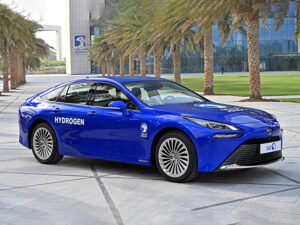Hydrom signs US$ 20bn contract with BP and Shell; Other Gulf nations investing in pink and blue hydrogen
Oman is dedicating an area the size of Slovakia to solar power projects to produce green hydrogen, reports Jonathan Gorvett, reporter for AGBI, a new London-headquartered media platform that provides intelligence and analysis around the Middle East’s commercial opportunities and challenges.

Sometimes it takes a country. The Sultanate of Oman is dedicating an area the size of Slovakia to solar power projects to produce green hydrogen, gas produced entirely from renewable sources.
On June 1 of this year, Salim Bin Nasser Al Audi, the Omani Minister of Energy and Minerals, signed US$ 20bn of contracts with partners including BP, Shell and the newly formed Hydrogen Oman (Hydrom) to produce 500,000 tonnes of green hydrogen annually.
Later in July 2023, Hydrom announced that ‘solidified commitments’ to initiatives in the Sultanate had risen to US$ 30bn. Production targets are 1mn tonnes by 2030, 3.75mn tonnes by 2040 and 8.5mn tonnes by 2050. This should make the Sultanate the world’s sixth largest exporter of hydrogen by 2030.
By 2040, those exports are projected to be worth 80 percent of Oman’s current exports of liquefied natural gas (LNG), according to the International Energy Agency. By 2050 they may be worth twice as much as the sultanate’s current overseas LNG sales.
Yet hydrogen is not without challenges. Technical issues limit long-distance transportation of the gas, while regulations and international markets are also still being worked. Hydrom signs its first deals. Oman has set bold targets to develop green hydrogen facilities.
Other Gulf nations taking different path
While Oman is focusing on green, the UAE is supporting blue, pink and green hydrogen.
Saudi Arabia has taken a similar approach. Both are also investing in developing domestic industrial uses of hydrogen to produce commodities such as green steel, mitigating the challenge of exporting the gas.
Qatar is largely outsourcing hydrogen production, continuing to ship its LNG to destinations where, if the off-taker desires, it can be used to produce blue hydrogen.
The Hydrogen Rainbow
Green hydrogen is the term used to describe hydrogen that is produced on a carbon dioxide-neutral basis through the electrolysis of water.
Turquoise hydrogen is created by a thermal process in which natural gas is broken down with the help of methane pyrolysis into hydrogen and solid carbon.
• Blue hydrogen is generated from the steam reduction of natural gas.
• Grey hydrogen is obtained by steam reforming fossil fuels such as natural gas or coal.
• Sometimes other colours are ascribed to hydrogen, based on how it is produced. For red, pink and violet hydrogen, the electrolysers are driven by nuclear power.
• Yellow hydrogen refers to hydrogen production from a mixture of renewable energies and fossil fuels.
• Hydrogen that is merely a waste product / by-product of other chemical processes is referred to as white hydrogen, while the use of coal as a fuel produces brown hydrogen.
Bahrain has decided that its combination of depleted wells and small land area make it more suited to carbon capture, storage and utilisation than hydrogen.
Kuwait, meanwhile, has yet to announce a domestic hydrogen strategy, although it has invested in schemes abroad. EnerTech Holding, a Kuwaiti state-owned company, is a partner in one of the new Omani projects.
Oman is also pursuing its own path when it comes to industry organisation. The Sultanate has offered blocks of land on which companies can build renewable energy projects. The Omani State with Hydrom will also hold a stake in those projects.
Oman’s decision to go for green is partly explained by the fact that it has some of the world’s leading renewable energy resources, according to S&P. The relatively high price of the gas compared to the huge quantities of cheap renewable energy that are set to become available – plus Oman’s relatively small population and economy – means the bulk of the hydrogen generated will be for export.
This means getting to grips with the problem of transportation. Converting it into hydrogen-heavy ammonia for shipping on tankers is one possible solution. It is then converted back into hydrogen at its destination.
(With input and credits from Reuters)
